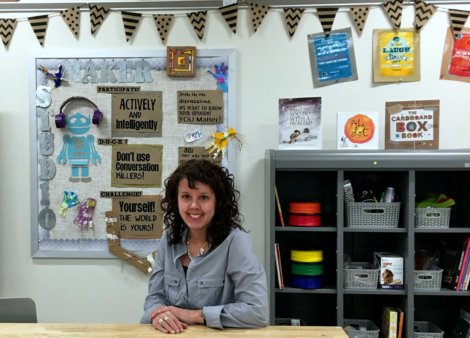
BrainPOP in College Classes? You bet!
Posted by Andrew Gardner on
Guest Blogger Cindi Smith-Walters, PhD is a professor of biology at Middle TN State University, co-directs the MTSU Center for Environmental Education, and is a past president of the Tennessee Academy of Science. She is a life-long environmental educator and a BrainPop believer who has used BrainPop with students of all ages. This is her experience using BrainPOP in college classes:
I use BrainPop with my University biology class designed specifically for elementary education majors. Many pre and in-service teachers have a poor understanding of science and the important role it plays in everyday life. With more state and National mandates to improve literacy and mathematics, and with high-stakes testing focusing so heavily on reading and math, one subject gets left behind – science. When students arrive in my classroom they have already had science poured all over them. But it isn’t always absorbed. All have had a minimum of 8 hours of college level science courses and can list topics and key vocabulary, but are literally asleep when it comes to the ‘how’ of science and to application of science in everyday life. BrainPop is a favorite tool to introduce and/or review science content information. It simply and understandably reinforces topics covered in previous high school and college courses and prepares my students to cover that same information in greater depth in our lecture and lab time.
Let me give you an example of a technique I use early in the semester to introduce kingdoms of life.
Before addressing the topic in class I take the last 10-20 minutes of the day and have students write down what they already know in their BoB (Book of Biology). Typically lists are fairly short with few students – if any – able to list the kingdoms much less name them. This brief activity allows students to examine current knowledge and reveal gaps in their personal understandings. Our next step is to make a list of three to five questions that they have about kingdoms of life. This segment goes very quickly because they have already personally identified what they do not know about the topic. I rarely have them compare lists prior to leaving class although I often overhear talk about their questions as they leave. The homework assignment that follows is to go to BrainPop and view the movie ‘Six Kingdoms’. If any of their questions are answered, or if previous knowledge is updated/revised they are to write these responses in BoB. Upon returning to class we share questions and answers with the whole group and table teams will meet and write down new questions that have arisen. I then lecture on the kingdoms of life and students check to see how many of their questions were answered within the lecture. Of course Q & A time is provided for those questions that are not addressed via lecture.
This approach gives students a personal interest in topics they might otherwise have never explored in a meaningful way. Listening for answers to questions they individually developed encourages more and deeper questions. Students move from passive listening to active thinking about a topic. I’ve been pleasantly surprised to note that the second time I use this teaching strategy many students will go a step further than the required assignment and read the Related Reading sections and/or look at the Q & A section questions provided with the movie.
Again, I use BrainPop in a variety of ways, but most importantly to strengthen life science content and principles. For example, when covering biomes I will assign several BrainPop movies; ‘Deserts’, ‘Land Biomes’, ‘Oceans’, ‘Savanna’, ‘Taiga’, ‘Tropical Rainforests’, ‘Tundra’, etc.) then have students choose two different biomes and develop a Venn diagram comparing and contrasting the two in at least 10 different ways. Or when exploring population principles and how exponential growth affects the use of natural resources, I might assign ‘Population Growth’ or ‘Natural Resources’. When wrapping up symbiotic relationships I can use the quiz or activity sheet from ‘Symbiosis’ as a check for understanding. When discussing how traits are passed from parent to offspring I may choose from movies and associated activities such as ‘DNA’, ‘Heredity’, and ‘Genetics’. BrainPop allows me to introduce or review information with approaches that are non-threatening to the science-phobic students.
Modified versions of BrainPop movies and activities are used as well. ‘Plant Growth’ is a great when students germinate seeds or grow garlic from bulbs in the classroom. For 4-6 weeks as those seeds or bulbs grow, students take a few minutes at the beginning of each class period to write and record data in journals. Sometimes we take digital pictures and produce Power Points suitable for use in elementary classrooms on the topic. These presentations become lessons for later use in classrooms of their own. BrainPop provides a fine example for them as they develop their own media.
Each semester students develop a ‘resource box’ of materials and activities for future use. This box contains at least 2 collections of natural objects (leaves, seeds, flowers, insects, etc.), ready-to-use packaged activities from resource guides, and miscellaneous teaching materials that are purchased, teacher made, or scavenged. Not surprisingly, many students choose to make activity packets correlated to BrainPop videos for inclusion in their boxes. There are required guidelines to follow when choosing activities – and science content information must be reinforced. Cross-referencing to activity packs acquaint these pre-service teachers with BrainPop in a much deeper and more meaningful way.
Rather than ‘pouring knowledge’, BrainPop allows me to nurture the seeds I’ve ‘planted’ within my students. Fostering those same seeds throughout the semester via homework assignments, data collection, journaling, and experiences keeps knowledge growing. Putting together the resource box, assembling collections, and developing activity packs forces students to personalize learning. Lastly, using and participating in BrainPop prepares students to become professional educators and builds confidence in the delivery of science content.
I encourage others to use BrainPop with students of all ages!














